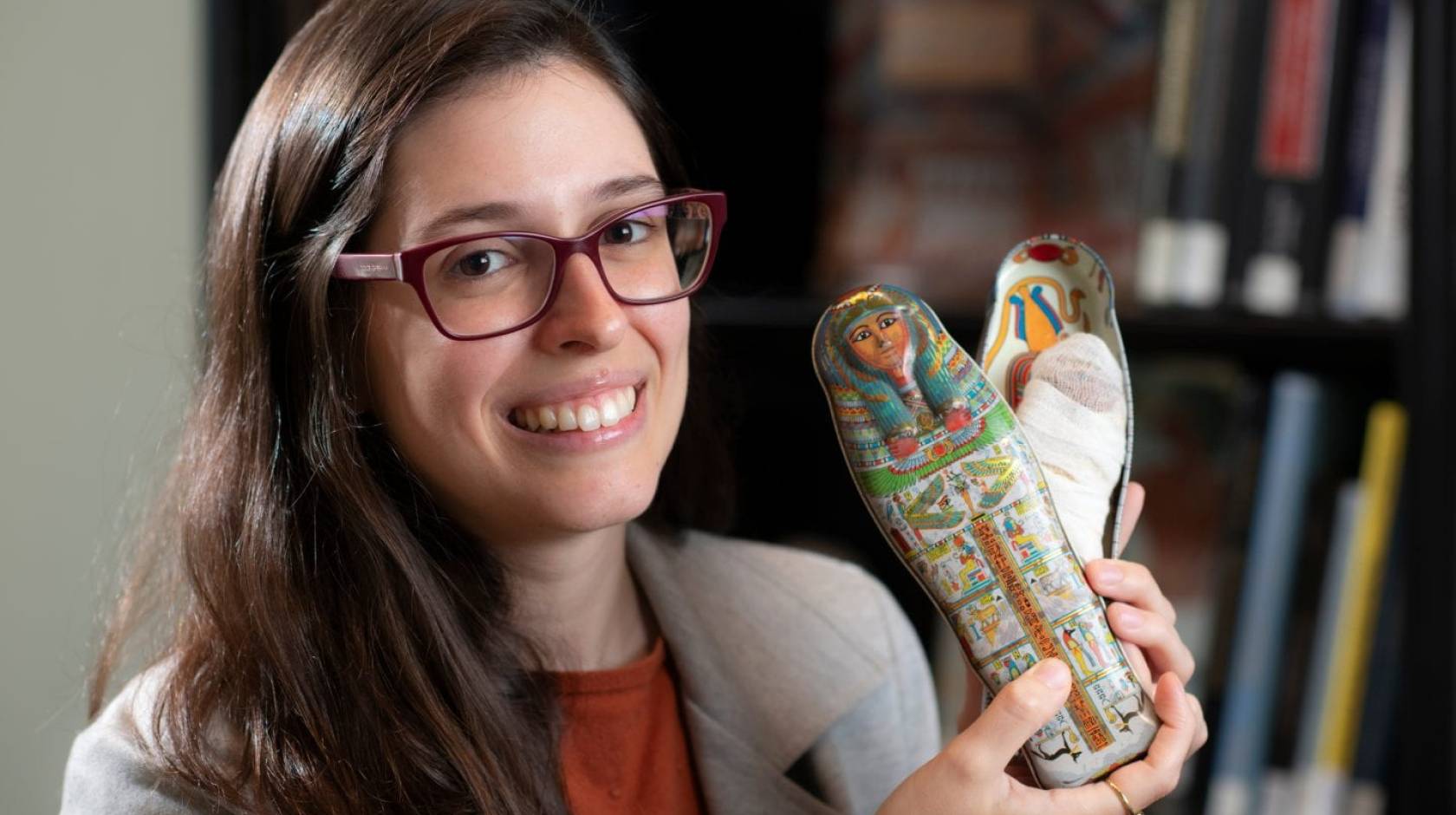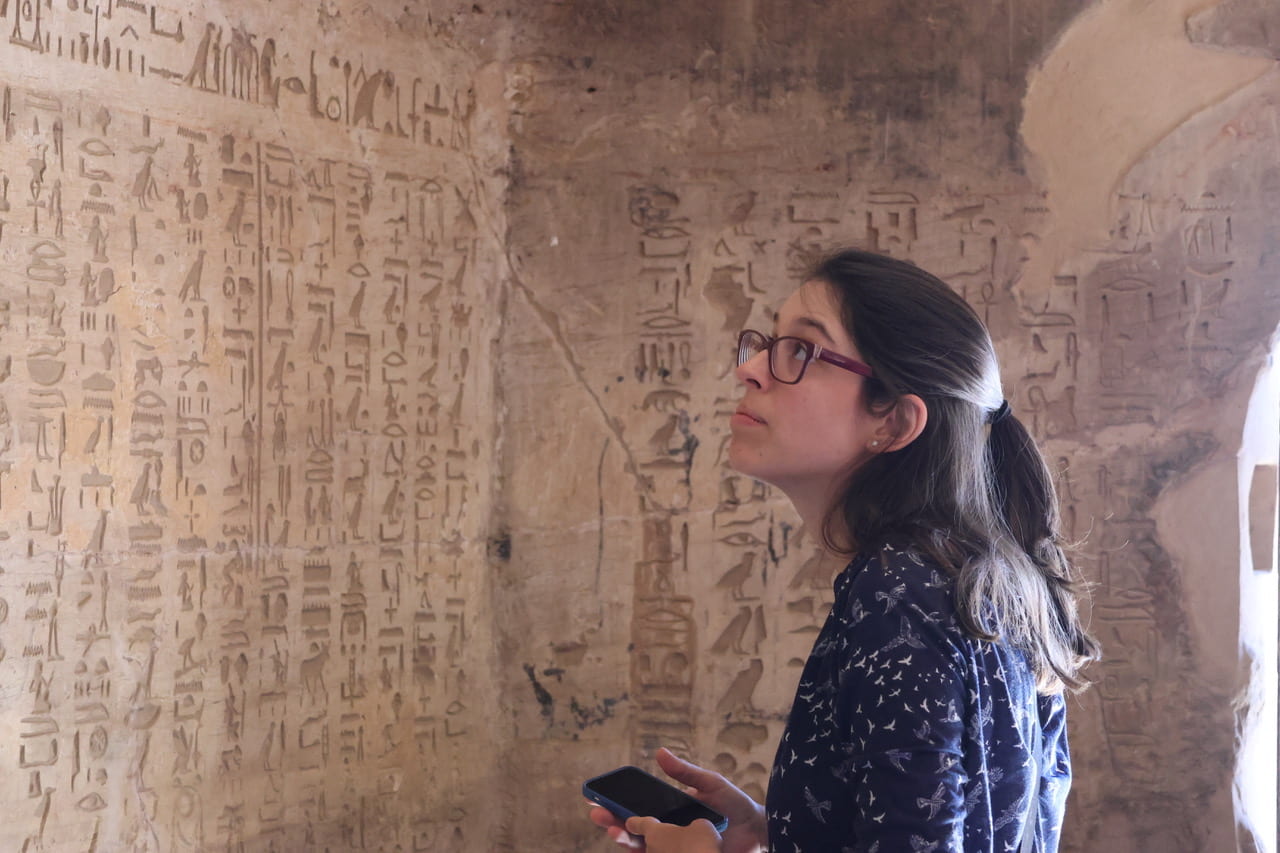Roy Rivenburg, UC Irvine

She haunts ancient Egyptian graveyards, co-hosts a Portuguese podcast called “Three Egyptologists Walk Into a Bar” and keeps a miniature mummy in her office.
Last fall, Luiza Osorio G. Silva joined UC Irvine as an assistant professor of art history specializing in pyramids, sphinxes, pharaohs — and a splash of beer.
Early Egyptians drank lots of ale, she says.
They also believed statues were able to live and breathe after a ceremonial knife was used to open their mouths. “Art in Egypt was not just art,” Silva notes. “Statues of gods were considered living gods, and the verb for sculpting one translated to ‘birthing’ rather than ‘making.’”
Originally from Brazil, Silva traces her fascination with the land of the Nile to watching mummy movies with her dad as a kid. And when she was 5 or 6, the family traveled to England and visited the British Museum’s Near East collection and gift shop — from which Silva returned with a small metal coffin and a figurine that she wrapped in gauze and placed inside. Today, the makeshift mummy rests on a shelf in her office.
Armed with Egyptian archaeology degrees from Brown University and the University of Chicago, Silva has researched everything from “magical bricks” found in old tombs to how royalty was perceived by average citizens. She’s also involved with a trio of Middle East excavation projects.

One of Silva’s goals is to demystify early Egypt for the general public and show its relevance to modern times. In 2022, she and two other scholars launched a Portuguese podcast called “Tres Egiptologues Entram num Bar” that uses pop culture portrayals of Egypt as a hook to introduce scientific studies of the civilization’s past. A spinoff book club discusses Egyptian-themed novels by the likes of Agatha Christie and Ellery Queen.
In a similar vein, Silva’s UC Irvine classes have students create a virtual art museum exhibit, a podcast or a historical character study as a final project. Her inspiration for the assignments was a Brown University course in which she had to make a Facebook profile for an Egyptian queen named Ahhotep. As part of her presentation, Silva concocted Nile Valley parodies of modern slang and idioms. Instead of YOLO (“You only live once”) and “I love you to the moon and back,” her glossary featured YOLF (“You only live forever”) and “I love you to the land of the dead and back.” OMG was replaced by OMA, for “Oh, my Amun,” a famous old-world god. And #drinkbeer was a key hashtag.
Hiring an Egyptologist is part of the art history department’s ongoing effort to expand its geographic and chronological depth, says James Nisbet, who chairs the program. Although the department has long included Egyptian art and architecture among its broad history classes, Silva’s courses — such as “Pyramids and Power” and “Imagery of Violence” — are the first Nile-centric offerings.
Fittingly, her office is sprinkled with Egyptian kitsch, including a serpent-handled coffee mug, an itty-bitty pyramid and a fake papyrus painting of goddesses on a boat. “I have more at home,” she says.
And, of course, Silva is ready to hold forth on all manner of Egypt arcana and trivia, from the 1922 discovery of King Tut’s tomb (a media circus) and creepy mummification methods (brains were removed through the nostrils) to maddening myths (no, the pyramids weren’t used to store grain) and her favorite beverage (karkadeh — hibiscus tea).
When asked about the Bangles’ 1986 song “Walk Like an Egyptian” (a phrase that also turns up in the movie version of To Kill a Mockingbird), Silva pulls out artwork depicting a man with one crooked arm stretched forward and the other reaching back. Pointing out that his head faces sideways, but his eye faces the viewer, she says, “It’s not because Egyptian artists didn’t understand perspective. We think they were simply trying to show the most recognizable parts of whatever they painted. In this case, the eye is more recognized frontally.”
As further evidence, she displays a second piece of Egyptian art — an aerial view of trees around a rectangular pool, except the trees look like they’re lying flat on the ground, and the fish and ducks in the pool are likewise seen from the side instead of from overhead.
Silva’s Egyptomania has spread to her parents, who were skeptical when she switched majors in college but now love to watch documentaries about the civilization. However, their daughter doesn’t join them. “Seeing a documentary reminds me of work,” she says. “I prefer a good mummy movie.”

